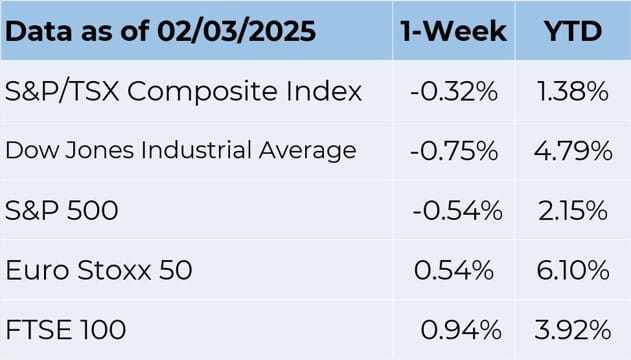Weekly Market Commentary February 6 2025
Canada on Edge Over Tariff Threat
Canada's central bank invoked the first interest rate cut for the New Year, bringing the benchmark rate down to three per cent. The 25 basis point cut, announced last week, was half the 50 basis point cut in December but crucial in offering support to an economy facing a string of challenges mostly tied to trade headwinds.
According to TD Economist James Orlando, the continued interest rate cut clearly indicates that the Bank of Canada is committed to maintaining economic momentum. The 50 basis point cut in December appears to have significantly impacted the Canadian economy. The gross domestic product bounced back to a 0.2 per cent growth in December, which was up from a contraction of 0.2 per cent in November. The bounce back in December is a clear indication that interest rates are working.
The interest rate cut may result in lower mortgage rates for many Canadians. The BoC's lending rate influences financial institutions' interest rates on a range of products, such as loans and mortgages. Because of this, Canadians who have variable-rate mortgages might discover that a larger portion of their monthly payment is applied to principal rather than interest, which would lessen their financial strain.
Although business investment is still weak, there have been indications that housing activity and consumption in Canada have improved, as borrowing costs have decreased. Early analysis of retail receipts revealed that December sales were up significantly, most likely as a result of the beginning of a two-month tax holiday on certain purchases.
Inflation has been at or below the central bank's target for five consecutive months, and employment also improved in the final two months of 2024. In the current quarter, the central bank predicted that Canada would grow by two per cent annually. In the absence of new tariffs, policymakers also expect GDP to grow 1.8 per cent in 2025 and 2026, as opposed to their initial projections of 2.1 per cent growth this year and 2.3 per cent growth the following year.
While the Bank of Canada expects GDP growth to pick up amid the low interest rate environment, the risk of trade tariffs from the U.S. poses significant risks. While President Donald Trump has paused the 25 per cent tariff imports on Canada for one month, it is still unclear if they will come into play next month.
Economists caution that a protracted trade with the U.S. will likely slow Canada’s economy and possibly trigger a recession. That’s because Canada heavily relies on the United States for exports such as oil, agricultural products, and forest products.
Meanwhile, Canadian stocks are on recovery mode after suffering their biggest loss since August of last year. The country’s main stock index, the Toronto Stock Exchange, was down by about three per cent at one point as investors reacted to Donald Trump's threat of imposing 25 per cent tariffs on Canadian equities. The Index bounced back as the trading session came to a close, as Trump confirmed the tariffs would be delayed for a month. Nevertheless, the TSX ended the day down by about 1.1 per cent to 25, 241.
Important sectors of the Canadian economy are at risk due to the Trump administration's protectionist stance. The impact that such tariffs would have on Canadian oil stocks, in particular, is already evident. The apparent option for oil and gas investors who wish to remove tariff risks is to purchase U.S. energy stocks and reduce their holdings of Canadian energy stocks. This is especially true, given that a number of Canadian pipeline and natural gas companies are lagging behind U.S. natural gas companies.
The Markets
Wait! What just happened?
Last week, investors were inundated with market-moving data and news.
Stock markets gyrated as investors tried to process everything that was occurring. Here’s some of what happened:
China surprised the artificial intelligence industry
The week got off to a rough start with major United States stock indices declining sharply on concerns about competition from China in the artificial intelligence (AI) space. AI-related technology stocks sold off after a Chinese start-up released a less expensive AI model, raising concerns that current tech stock valuations may be too rich, reported Rita Nazareth of Bloomberg. Over the course of the week, markets “clawed back most of those losses thanks to encouraging earnings and company strategy updates, and as some investors re-evaluated the risks U.S. firms face from Chinese competition,” reported Barron’s.
Companies performed well
Last week, fourth-quarter earnings reports bolstered investor optimism. So far, 36 per cent of the companies in the Standard & Poor’s (S&P) 500 Index have reported on fourth quarter earnings. Seventy-seven per cent of those companies have reported earnings that exceeded estimates, reported John Butters of FactSet.
Economic growth continued
In addition to upbeat earnings news, economic data released last week showed the U.S. economy continued to grow in the fourth quarter of 2024. “The [economic growth] figures cap another solid year for the world’s largest economy that defied expectations for a marked slowdown as consumers hung tough in the face of persistent inflation and high borrowing costs. The economy grew 2.8 [per cent] in 2024 after expanding
2.9 [per cent] and 2.5 [per cent] in the prior two years, respectively,” reported Molly Smith of Bloomberg.
Inflation persisted
Last week’s inflation data was less encouraging. The Personal Consumption Expenditures Index, which is one of the Federal Reserve’s favoured inflation measures, showed that headline inflation moved higher in December, rising to 2.6 per cent annualized from 2.4 per cent annualized in the previous month. Core inflation remained steady at 2.8 per cent annualized.
The Federal Reserve paused
The Fed left rates unchanged last week. The range for the federal funds rate remained 4.25 per cent to 4.50 per cent. The accompanying statement said, “The risks to achieving [the Fed’s] employment and inflation goals are roughly in balance. The economic outlook is uncertain, and the Committee is attentive to the risks to both sides of its dual mandate.” Stocks moved lower initially but calmed after the Fed Chair offered assurances that monetary policy is well-positioned for whatever may be ahead, reported Caroline Valetkevitch of Reuters.
Uncertainty abounded
Government policy proposals arrived at a rapid pace, creating uncertainty. The White House Office of Management and Budget issued a memo temporarily pausing disbursement of government grants and loans, but no one was certain how the pause would affect the economy. “The
federal government gives $1 trillion in grants to state and local governments alone, for everything from physical infrastructure and public safety to health and social services. Removing this money from the economy would represent a huge economic shock,” reported Samantha Sanders and Josh Bivens of the Economic Policy Institute. A federal judge temporarily blocked the freeze.
Tariffs threats loomed
Tariff talk had a more immediate effect on markets than the spending pause. U.S stocks slipped lower on Friday after the White House indicated it will move forward with tariffs on Canada, Mexico, and China, reported Connor Smith of Barron’s. “Investors are bracing for a looming hit to U.S. corporate profits and pressure on inflation if President Donald Trump makes good on his tariff threats, with markets seen as not fully factoring in risks from higher levies on foreign imports,” reported Laura Matthews, Lewis Krauskopf and Suzanne McGee of Reuters.
Investors had a lot to consider last week. As the dust settled and the exchanges closed for the week, the Dow Jones Industrial Average had recovered its losses and moved slightly higher. The S&P 500 and Nasdaq Composite Indices had regained some losses but ended the week lower. All three indices had gains over the full month, reported Lisa Kailai Han of CNBC. The yield on the benchmark 10-year U.S. Treasury fell sharply on Monday and moved higher over the week.

Source: FactSet
What Do You Know About The Big Football Game And Game Day Parties?
You might be surprised to learn that many of the friends and family who gather to watch the Big Game are more interested in the snacks than the
game. A recent survey from Talker Research found that 48 per cent of respondents care who wins the game. Fifty-four per cent said the food served would decide whether a Big Game was great. See what you know about the Big Game and game day gatherings by taking this brief quiz.
- Which team has never played in a Big Game?
- Cleveland Browns
- Jacksonville Jaguars
- Houston Texans
- All of the above
- What are the top three foods guests want to eat during the Big Game?
- Hot wings, barbecue, and seven-layer dip
- Chili, pigs-in-a-blanket, and chips
- Nachos, pizza, and brownies
- Buffalo chicken dip, sliders, and cowboy caviar
- What do people most look forward to at Big Game gatherings?
- The game
- The half-time show
- The commercials
- The drinks
- Approximately, how much do Big Game tickets cost this year?
- $2,500 to $25,000
- $3,500 to $35,000
- $4,500 to $45,000
- $5,500 to $55,000
What’s your favourite part of the Big Game?
Weekly Focus – Think About It
“The price of success is hard work, dedication to the job at hand, and the determination that whether we win or lose, we have applied the best of ourselves to the task at hand.”
—Vince Lombardi, NFL coach
Best regards,
Eric Muir
B.Comm (Hons. Finance), CIM®, FCSI
Senior Portfolio Manager
Derek Lacroix
BBA, CIM®, CFP®
Associate Portfolio Manager

P.S. Please feel free to forward this commentary to family, friends or colleagues. If you would like us to add them to the list, please reply to this email with their email address and we will ask for their permission to be added.
Disclaimer:
Information in this article is from sources believed to be reliable, however, we cannot represent that it is accurate or complete. It is provided as a general source of information and should not be considered personal investment advice or solicitation to buy or sell securities. The views are those of the author, Eric Muir and Derek Lacroix and not necessarily those of Raymond James Ltd. Investors considering any investment should consult with their Investment Advisor to ensure that it is suitable for the investor’s circumstances and risk tolerance before making any investment decision. Raymond James Ltd. is a Member Canadian Investor Protection Fund.

